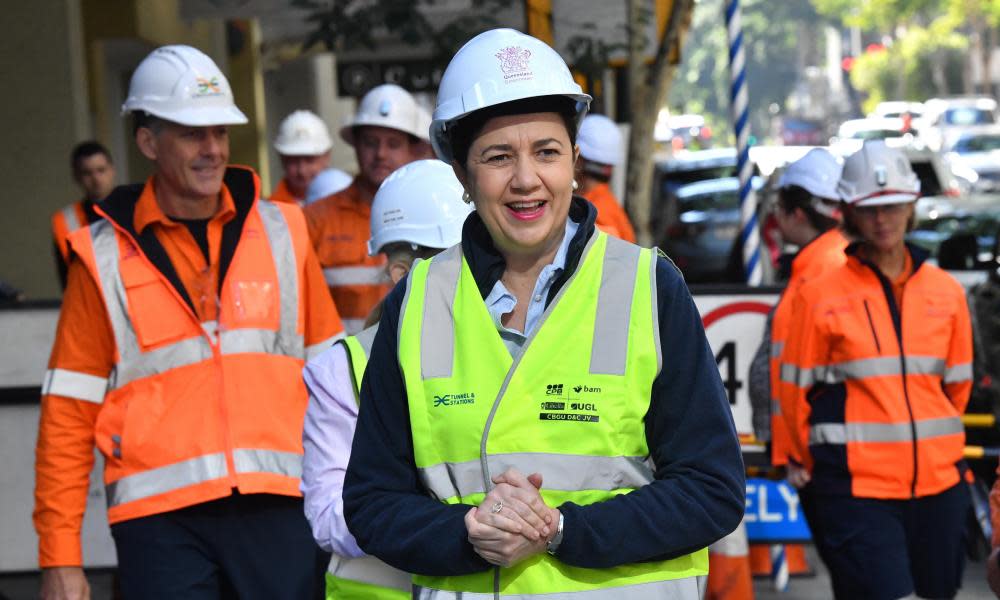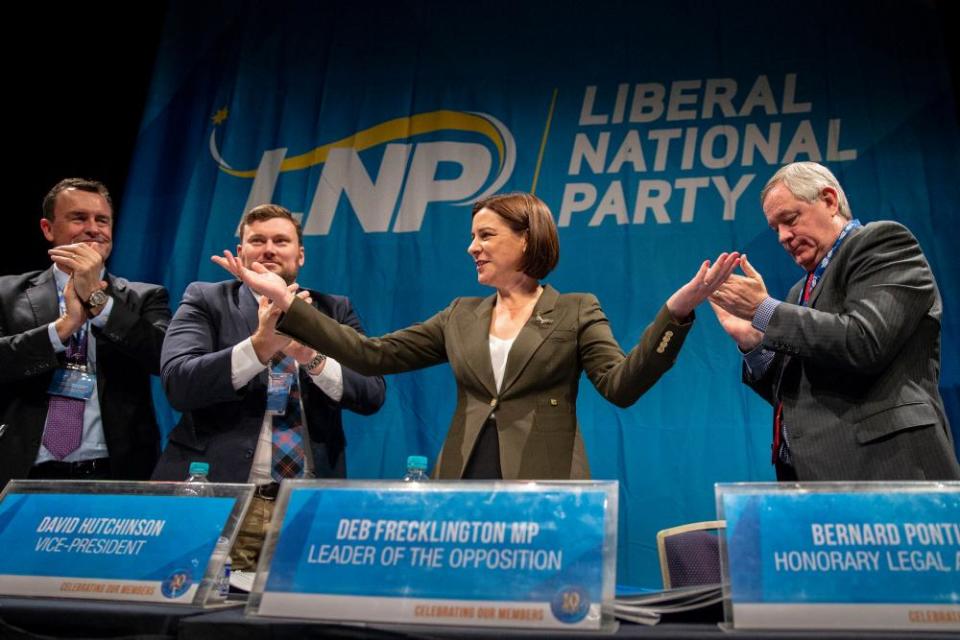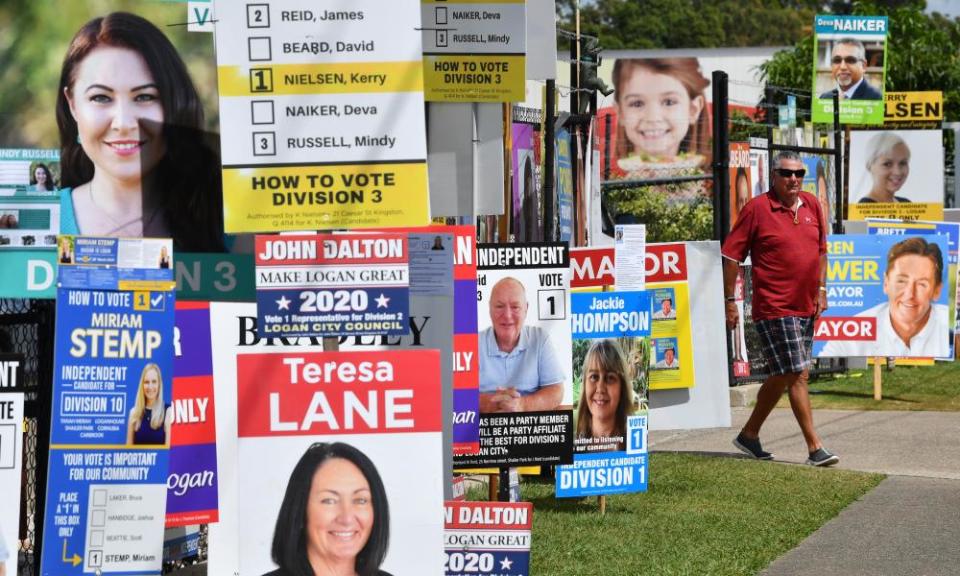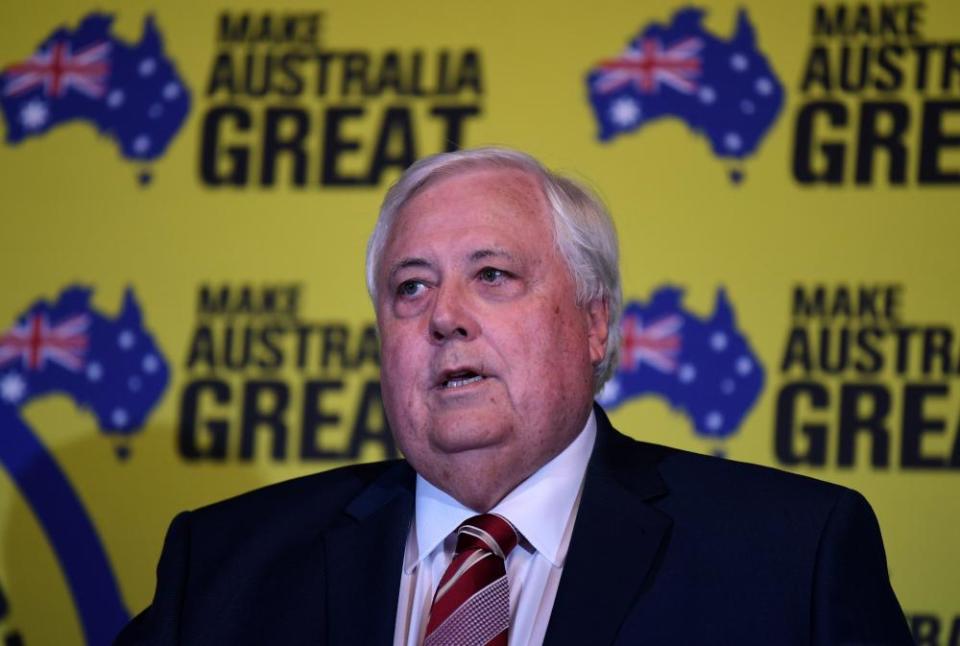Can Annastacia Palaszczuk hold on to 'fortress Queensland' in the Covid election?

The Queensland election will be held in six weeks and not a single baby has been kissed.
Candidates and party volunteers in Brisbane have taken to standing at major intersections waving campaign signs – or commandeering aircraft to display them – rather than wandering shopping centres or pressing the flesh with voters.
The first election debates have taken place via video calls.
The October 31 poll was never going to be an ordinary election campaign. Before the onset of the pandemic, pollsters and campaigners had predicted a hung parliament or a close result, largely shaped by shifting political sands in the city and the regions.
Labor is attempting to win a third successive term in Queensland, where the party has lost just one state election since 1989. Annastacia Palaszczuk’s government holds an effective two-seat majority in parliament – 48 of 93 seats.
With seven crossbenchers currently in the parliament, the Liberal National party opposition, led by Deb Frecklington, needs to win nine seats to govern in its own right.
Most recent opinion polls have shown the LNP has a consistent but narrow statewide lead, while there has been strong and increasing support for the government’s border closures and its handling of the pandemic.
The premier will take centre stage
Palaszczuk’s social media following has grown immensely since the first coronavirus outbreak. She is now followed by 190,000 people and liked by 165,000 – a 400-fold increase since last year.
The premier’s approval rating jumped 38 points in the most recent Queensland Newspoll, on 29 July. Her net satisfaction rating is now 35, up from -3 in October last year.
Her daily coronavirus briefings have given Palaszczuk an unprecedented platform during an election campaign. They allow her to focus on the pandemic, rather than crisscrossing the state to speak to voters, and in the process focus the campaign more intently on the single public health issue.
Labor is building a presidential-style campaign around Palaszczuk and her leadership. The premier’s rhetoric has also become increasingly parochial: putting “Queensland first” and announcing case numbers in other states that offer a favourable comparison.
The party’s response to a flying banner saying “she is heartless” last week was to send up a plane of its own. The election message trailing behind was, in a nutshell: “We are safe ’cause she is strong.”
Some of Palaszczuk’s sheen appeared to come off last week, amid attacks from federal LNP MPs about her border stance and the inconsistent application of exemptions.
With little ability to shape the agenda, the LNP has begun to target Palaszczuk, too.
“It’s no secret that whether or not Queenslanders still have faith in the premier in seven weeks’ time will probably also determine who wins,” a party figure told the Guardian.

An election with two female leaders
Never before has an Australian state or territory held an election where both major parties were led by women.
The LNP leader, Deb Frecklington, survived a backroom-led leadership challenge in June. The push was orchestrated after polling showed that she had failed to cut through against Palaszczuk.
Given the increasing likelihood of a campaign focusing on the leaders and the pandemic response, key figures within the LNP administration decided a change was needed to protect their narrow statewide lead.
Related: Piling into Palaszczuk: LNP gambles by targeting premier in Queensland election
About the same time, Frecklington was calling for the Queensland borders to be reopened; a defining campaign moment that has been seized upon by Labor after the second wave outbreak in Victoria.
Notionally a National, from the Bjelke-Petersen homeland of Kingaroy, Frecklington is more moderate than some of her regional Queensland colleagues. She stood up to the party’s organisation over threats to disendorse pro-abortion MPs, but was hit with backlash after she criticised Palaszczuk for her fashion choices and said she had “no choice but to remain grounded” because she had children.
Winning Queensland means winning seats in the city, and the regions
Statewide polls showing the LNP marginally ahead of Labor come with a caveat from experts; that the process often fails to take into account the complexity of the electoral landscape.
Queensland is the only mainland state where the majority of the population lives outside the capital, and this poses a campaigning problem for any party wanting to win statewide.
The LNP has identified 11 seats it hopes to win to take government; the path to victory relies on winning in working class regional areas, affluent progressive city seats, and suburban fringe electorates.
Labor believes it can win city fringe seats held by the LNP; at the same time commentators believe the government might have to fight a rearguard action in regional centres like Townsville, Maryborough, Mackay and Rockhampton.
Developing a winning election strategy in Queensland has always required walking both sides of the street.

Coal, gas or renewables? Everyone’s a winner.
Energy politics remains the crucible for any party to attempting to meld together enough regional and city seats to form government.
At the last election, in 2017, Labor’s victory was built around gains in Brisbane and a defence of its regional seats. The “two sides of the street” strategy was evident in its position on the Adani coalmine. It told city voters the state would veto any public funding. In coal country, Labor reiterated its support.
The LNP in 2017 campaigned on building a coal-fired power station in north Queensland, but has walked back from that commitment.
Both parties now broadly have policies supporting renewables, coal and gas, while suggesting any inherent conflicts in those positions should be dealt with in the longer term.
The space remains fraught. LNP MP Colin Boyce has paid for Facebook ads criticising renewables, leading to concerns within the party that climate sceptic regional MPs could damage its attempts to win city seats.
Labor is under pressure, including from the Construction, Forestry, Mining and Energy Union, to give the go-ahead to the New Acland coalmine expansion in the Darling Downs. This week, the CFMEU sent out anti-Labor campaign flyers in Toowoomba.
Can the minor parties keep their foothold?
Three years ago, much of the pre-election discussion was about the “One Nation Factor”, and whether the minor party could win enough seats to gain the balance of power.
One Nation won a single seat in 2017, but its preferences did shape the outcome in several key electorates. Katter’s Australia party won three seats in north Queensland, while the Greens won the inner-west Brisbane seat of Maiwar.
Both Labor and LNP sources say they expect the pandemic will result in otherwise disaffected voters turning back towards the major parties.
Chris Salisbury, a political historian and commentator from the University of Queensland, says council elections in March saw people attaching themselves to incumbents and major parties.
“We might see a bit of hardening of the votes behind the majors,” Salisbury said. “The dominance of the airwaves of the narrative by the government, and to a similar extent the opposition, is only going to make things more difficult to minor parties.
“Pretty much the only conversation is the pandemic. That doesn’t leave a lot of room for the minor voices to make much of an impression.”

Will the Greens surge in Brisbane?
The Greens have talked about the possibility of winning up to seven seats in inner Brisbane, capitalising on policy areas where Labor has drifted to the right to shore up its regional support.
Salisbury says the Greens’ progress could also be slowed by the pandemic focus of the campaign.
The party’s most high-profile target seat is South Brisbane, held by the former treasurer and deputy premier, Jackie Trad.
And what about Clive?
Clive Palmer’s United Australia party is running another spoiler campaign where its message is clearly to “give Labor the boot”.
He has not yet announced candidates in most electorates, but Palmer’s companies have already begun injecting cash into his political entity to help fund the yellow campaign billboards.
This week Palmer’s flagship company, Mineralogy, dropped $2m into the United Australia party bank account.
Palmer’s involvement in the federal election was controversial, given his party won only 3.4% of the vote but spent $80m on advertising to damage Labor. His ongoing links to Liberal National party backroom figures remain a source of tension within the party.

Don’t expect a re-run of the federal election
Scott Morrison likely won’t be allowed in to Queensland to campaign next month; though he and federal colleagues have already begun lobbing grenades at Palaszczuk’s “fortress Queensland”.
The Sunshine State was credited with delivering Morrison’s surprise victory last year. Much of the analysis focused on Queensland coal country, but the result was equally emphatic in suburban and inner-city areas.
The Queensland election won’t follow the same form guide. While the Coalition has dominated at federal elections in Queensland for decades, Labor has won all but one state election since 1989.
While the focus is on the coronavirus response and boosting the recovery, Salisbury says the usual economic themes of election campaigns, including a focus on checking spending and debt, will not feature as heavily.
“We won’t have that kind of clear differentiation between the parties which gives them a ready platform to attack each other from. They really are going to be singing from the same song sheet.”
Both parties have had their share of internal turmoil in recent months. Infighting has hampered the LNP’s start to the campaign. Labor unexpectedly lost its most senior ministers, Kate Jones and Anthony Lynham, who recently announced they would retire.

 Yahoo News
Yahoo News 
